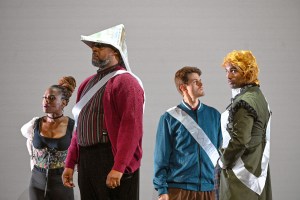
Kay Swift was the first woman to compose an entire Broadway score. The show was Fine and Dandy, a confection tailored to the talents of a little remembered comic named Joe Cook. During the 1930-31 theater season, Fine and Dandy ran neck and neck with the Gershwins’ hit Girl Crazy. Swift wrote a handful of songs (such as “Can This Be Love?,” “Whistling in the Dark,” and “Can’t We Be Friends?”) that are familiar from recordings, cabaret interpretations, and the waves of Muzak that form the soundtrack for contemporary urban life. Despite all of this, Kay Swift isn’t a household name. For posterity, she’s linked to the Gershwins, but the link isn’t Girl Crazy or anything musical; it’s her long love affair with the elusive bachelor George Gershwin.
Born into a well-educated family on the Upper West Side of Manhattan, Katharine Swift was surrounded from early childhood by artists and their art. Her father, a music critic, took her regularly to the concerts that he covered, and she prowled the backstage corridors of the old Metropolitan Opera House with a close comrade whose mother was one of the company’s stars. At the Institute of Musical Art (subsequently Juilliard), Swift received a rigorous musical education and made contacts that would serve her well for years to come. Soon after graduation, she married James Paul Warburg, scion of the German-American banking family that controlled M.M. Warburg in Europe and Kuhn, Loeb in the United States. The newlyweds were conspicuous in Manhattan’s Jazz Age society, socializing with the Irving Berlins, the Cole Porters, and the Algonquin wits. At their homes in New York City and Greenwich, Connecticut, Katharine and James threw Gatsby-scale parties that made them catnip for the gossip columns.
Defying social position and maternal obligations, Swift became a Broadway rehearsal pianist and professional composer. She understood implicitly the conventions of both classical and popular music. Endlessly inventive, she had a knack for experimenting with rhythm, harmony, and melody that made all of her songs arresting and the best of them unpredictable. With her taste for leopard print clothes and zebra skin décor, Swift had personal flair, as well. If she was an anomaly in the Warburgs’ world, her husband was, too; beneath a bland banker’s exterior, James Paul Warburg concealed a poetic sensibility and a gift for rhyme. Using the nom de plume Paul James, he served his wife as lyricist on Fine and Dandy and a number of popular songs.
Vicki Ohl’s Fine and Dandy: The Life and Work of Kay Swift (Yale University Press, 294 pp., $30), takes its title from the Warburgs’ one musical comedy collaboration. Ohl, a professor of music theory and piano at Heidelberg College in Tiffin, Ohio, has expanded a doctoral dissertation to create what the publisher describes as the “first full-scale biography” of this underappreciated contributor to the American songbook. The book offers a serviceable account of the outward details of Swift’s story but none of the psychological insight or cultural and historical context necessary for effective biography. Despite delectable tidbits from interviews with Swift’s survivors and contemporaries, Fine & Dandy sheds hardly more light on what made Swift tick than Terry Benes’ sketch of the composer in the lively, groundbreaking American Masters TV program from 1998, “Yours for a Song: The Women of Tin Pan Alley.” Rich in musical analysis, Fine and Dandy is a belated reassessment of Swift’s stop-and-go composing career, but it leaves her still overdue for comprehensive biographical treatment.
Swift outstripped her female competitors in American music when Fine and Dandy finished the 1930-31 season in a dead heat with Girl Crazy. After that, she became composer in residence at Radio City Music Hall and director of light music for the 1939 World’s Fair. Her subsequent songwriting career is marked by detours and mysterious dry spells. Those lags and gaps may be explained, in part, by the practical demands of nonmusical activities. They cry out nonetheless for psychological evaluation — and that’s what Ohl’s new book fails to deliver. Both Swift’s marriage to Warburg and her professional momentum appear to have been in jeopardy from the moment she crossed paths with George Gershwin; when the two met at a party in 1925, their attraction was, reportedly, immediate and evident to all in the room. Pauline Heifetz, Gershwin’s girlfriend at the time and his date at the party, recorded the shindig in her diary with the melodramatic legend, “Finita Really,” alluding to Pagliacci‘s cri de coeur, “La commedia e finita.” It was Kay’s bad fortune that Gershwin had an aversion to commitment as strong as his appetite for women.
Ohl’s Fine and Dandy contains few revelations about the dynamics of the Swift-Gershwin affair but a number of provocative clues. For Swift, Gershwin may have offered a jaunty, rough-edged contrast to Warburg’s Harvard-honed suavity. She coached him in etiquette and how to dress for mixing with the upper crust. Because Gershwin’s formal musical education had been modest, she tutored him in counterpoint and orchestration. Together, they studied advanced music theory. Adept at taking musical dictation, Kay notated Gershwin’s compositions as they flowed from his exuberant imagination. To her this must have seemed like peeking into the inner reaches of his creativity. As though to suggest that they’d come to view the world from the same perspective, she gave him a watch fob shaped like a dove, with gems as its eyes — one a sapphire, George’s birthstone; the other a diamond, which was Kay’s. Gershwin wore it as a talisman when he performed in public.

There are many ways in which one might assemble the puzzle pieces of this relationship. But, to quote a Paul James lyric from Swift’s most famous song, “this is how the story ends”: Swift subordinated her creativity to the service of Gershwin’s genius, functioning as his amanuensis and writing little or nothing of her own for the four years that followed the premiere of Fine and Dandy. Despite the magnitude of that sacrifice, she didn’t succeed in her apparent plan to meld her life to his. Oscar Levant, well-acquainted with Gershwin’s wandering eye and his wariness to commit, quipped: “Ah, look! Here comes George Gershwin with the future Miss Kay Swift!” Gershwin was known to find married women safer bets than single ones. Perhaps Swift’s availability after she divorced Warburg made her less attractive and more intimidating to him, or perhaps they both were astute enough to figure the lousy odds of Gershwin curbing his well-known yen for variety. Whatever the reason, Kay and George went their separate ways when the Gershwin brothers left for Hollywood in the summer of 1936. Less than a year later, at age 38, George died of a brain tumor.
Swift outlived Gershwin by 56 years. During those decades, she ran a horse ranch in Oregon with her second husband; wrote a humorous book that became a movie; tried her hand at screenwriting and composing film music in Hollywood; returned to New York; and wrote songs for one more Broadway show, Paris ’90. Through it all, she remained a keeper of the Gershwin flame. In the late 1950s, she rambled the country promoting the film version of Porgy and Bess. In a memoir, she wrote: “During my tour with the picture, I met more than one woman who felt, probably with reason, that she was the love of [George Gershwin’s] life. Perhaps, just as he used to sing every song with a peculiarly personal style at parties, directed right to a selected feminine listener, he conveyed in life a concentration upon each of his ‘crushes’…that engendered in her the feeling that she was The One And Only; whereas, the truth probably was that she was, currently, the one, but not the only.”
What if Kay Swift had never met Gershwin? Might she have avoided the barren patches in her career? Would she be a household name today, like her contemporary Dorothy Fields, rather than the hardly known composer of a handful of tunes that everyone recognizes? Impossible to say. What’s clear is that, despite not living up to her youthful promise, Kay Swift is (in no particular order) a formidable figure in women’s history, a significant link in the development of American music, and an integral part of 20th-century culture. Ohl’s little volume, while fine and dandy for now, whets the reader’s appetite for the more comprehensive treatment that Swift’s story deserves. In the meantime, PS Classics, the brainchild of Tommy Krasker and Philip Chaffin, has released an all-star studio recording of Fine and Dandy that shows the real reason why Kay Swift should be discussed in the same breath as George Gershwin: her abundant musical gifts.







